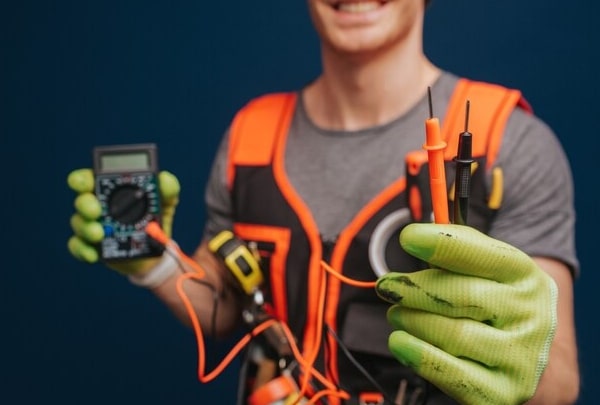Why Proper Ceiling Fan Installation Matters
Installing a ceiling fan might look simple, but the truth is, it affects more than just airflow. When an electrician Port St Lucie expert mounts it correctly, it helps regulate indoor temperature without straining your HVAC system. Over time, this lowers energy use and reduces wear on your heating and cooling equipment. Beyond function, a fan that’s balanced and secure creates a quieter, safer environment. A poorly installed unit, on the other hand, can wobble, wear down quickly, or worse, become a hazard. At Treasure Coast Contractors, every ceiling fan installation follows tested electrical standards because that’s the level of safety and performance your space should rely on.
Why a Certified Electrician Makes All the Difference
There are key reasons homeowners in Port St Lucie should bring in a licensed Port St Lucie electrician when it’s time to install or upgrade a ceiling fan. First, Florida building codes require safe electrical practices, and professionals stay updated on them. Second, your existing electrical box may not be rated to hold the weight or handle the wiring needed for a ceiling fan. Third, even a minor mistake in wiring or mounting could lead to short circuits, tripped breakers, or fire risks. A trained licensed electrician Port St Lucie locals trust, knows how to troubleshoot these situations right from the start. By hiring someone qualified, you reduce risks and avoid hidden costs caused by faulty setups.
Ceiling Fan Wiring Isn’t a DIY Guess
Proper wiring plays a major role in how your ceiling fan performs. If the connections aren’t done right, your fan might work intermittently, not respond to switches, or spark a circuit issue. The challenge isn’t just connecting a few wires—it’s knowing how to match the fan’s wiring to your existing electrical system, identify the circuit load, and ensure secure grounding. Without proper handling, it’s easy to cause permanent damage to your electrical infrastructure.
Here’s a breakdown of how local electrician Port St. Lucie professionals install a ceiling fan safely and effectively:
Check Circuit Capacity
Before anything else, a licensed electrician checks whether the circuit has enough capacity to support a new fixture. Ceiling fans draw more current than basic light fixtures. Adding one to a weak or overloaded circuit can cause flickering lights or frequent breaker trips.
Upgrade to a Fan-Rated Electrical Box
Standard boxes designed for light fixtures aren’t strong enough for ceiling fans. Port St. Lucie electricians install fan-rated boxes built to support both the weight and the vibration. This switch is non-negotiable for long-term safety.
Secure Mounting Bracket
Ceiling fans need a solid bracket to stay balanced and avoid shaking. A secure bracket ensures the fan doesn’t come loose over time. This also helps prevent noise and friction from damaging internal parts.
Proper Wire Matching and Connections
Ceiling fans typically have multiple wires for different functions—light kit, fan motor, and sometimes remote control modules. An home electrical repair service Port St. Lucie expert identifies and connects each wire to the correct switch and circuit to avoid functionality issues later.
Grounding for Safety
Grounding prevents electrical shock. Every ceiling fan must be properly grounded to meet code and keep users safe. Skipping this step or getting it wrong could lead to a serious risk in the event of a fault.
Test Run and Final Check
Once the fan is installed, it’s tested on all settings. Electricians ensure the fan blades rotate smoothly, respond to controls, and operate without vibration. They also inspect the wiring for secure and safe connections.

Ceiling Fan Wiring Isn’t a DIY Guess
When it comes to ceiling fan installation, many Port St Lucie homeowners share the same questions. Here are some of the most common ones we get at Treasure Coast Contractors:
What type of electrical outlet do you need for a ceiling fan?
Ceiling fans must connect to a ceiling-mounted, fan-rated electrical box that’s anchored to a support brace. Wall outlets aren’t used. It’s not about just power—it’s also about structure and safety.
How to tell if your ceiling fan was installed correctly?
A properly installed fan doesn’t wobble, hum loudly, or shift over time. It should respond consistently to the switch or remote, and the blades should spin evenly. If the fan rocks or makes clicking noises, the mounting or wiring may not be secure.
Can you install a ceiling fan where a light fixture is?
Yes, but only if the existing junction box is replaced with one rated for ceiling fans. Standard boxes used for lights can’t safely support the fan’s weight or movement.
How to tell if a light fixture can support a ceiling fan?
Look at the mounting box. If it’s plastic or not securely attached to a ceiling joist or support brace, it’s not fan-rated. Fan-rated boxes are typically metal and labeled as such.
What kind of light switch do I need for a ceiling fan?
You can use a standard single-pole switch or upgrade to a dual-control switch that lets you manage the light and fan separately. Some fans also allow remote or wall-mounted speed controls.
Work With Home Electrical Repair Service Port St. Lucie Experts
Hiring a licensed electrical service Port St. Lucie technician is about ensuring your ceiling fan works exactly the way it should for years. An experienced professional knows how to assess the space, confirm code compliance, and eliminate wiring risks before they become problems. Skipping that step often leads to silent failures that show up later.
Need expert ceiling fan installation from a team that understands the details behind the wiring? Let Treasure Coast Contractors handle the work while you stay focused on your space. Our electrician Port St Lucie services are straightforward, reliable, and built for results that last. Book your consultation now at https://treasurecoastcontractors.com/, and we’ll take care of the rest safely and correctly.
